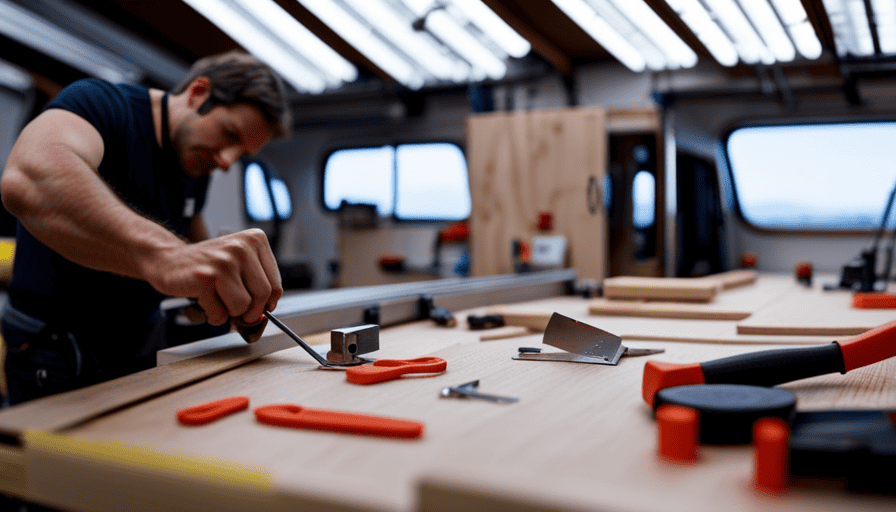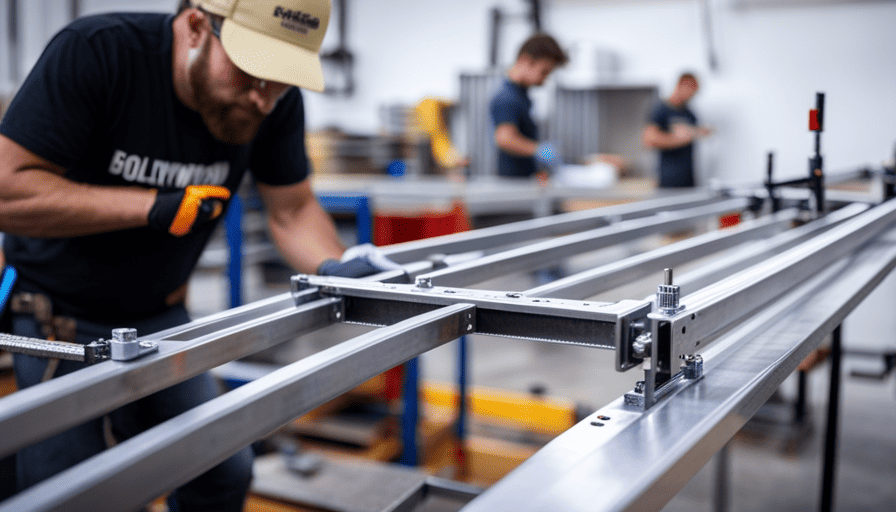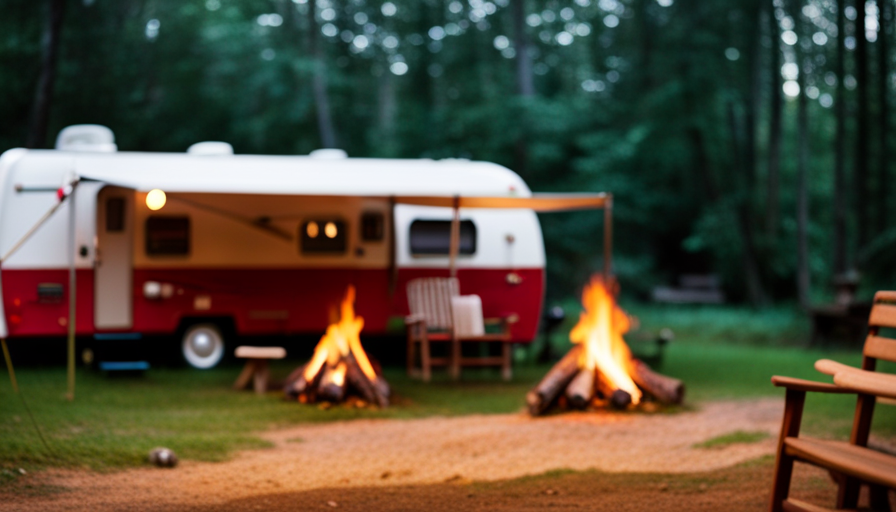Experience adventure and liberation with a Class B camper, where the open road is your playground and the opportunities are limitless.
Like a hidden gem waiting to be discovered, a Class B camper is a compact and versatile home on wheels, designed to provide you with the ultimate travel experience. This miniature marvel combines the convenience of a motorhome with the maneuverability of a van, making it the perfect companion for those seeking to embark on spontaneous journeys or navigate narrow city streets with ease. If you’re looking for a camper that is easy to park and navigate, a Class B camper is the way to go. It offers all the amenities and comforts of larger RVs, without the hassle of driving or parking them. In contrast, fifth wheel campers require a larger, more powerful vehicle to tow them and can be more difficult to maneuver in tight spaces. With a Class B camper, you can enjoy the freedom to explore without any limitations.
From its cozy sleeping quarters to its fully-equipped kitchenette, a Class B camper offers all the comforts of home in a compact and efficient package.
Join us on an exploration of the world of Class B campers, as we dive into their unique features, advantages, and stories from passionate owners who have embraced the spirit of wanderlust.
Key Takeaways
- Class B campers are compact and versatile homes on wheels that offer the convenience of a motorhome with the maneuverability of a van.
- They are built on standard van chassis, making them smaller in size compared to Class A and Class C RVs, which allows for easier driving and parking in crowded areas and better fuel efficiency.
- Class B campers have cozy sleeping quarters and fully-equipped kitchenettes, making them suitable for spontaneous journeys and navigating narrow city streets.
- Regular maintenance is crucial for keeping Class B campers in top shape, and they may not be suitable for larger families due to their limited space.
Definition and Overview of a Class B Camper
So you’re wondering what a Class B camper is, huh? Well, let us break it down for you.
A Class B camper, also known as a camper van or a motorhome conversion, is a compact recreational vehicle that offers the convenience of a home on wheels. These vehicles are built on a standard van chassis and are smaller in size compared to their Class A and Class C counterparts.
One of the main advantages of a Class B camper is its versatility and maneuverability. Due to its compact size, it’s easier to drive and park in crowded areas, making it ideal for urban adventures. Additionally, Class B campers often have better fuel efficiency compared to larger motorhomes.
However, there are some disadvantages to consider. The limited space inside a Class B camper means that amenities and storage may be more limited compared to larger RVs. It may not be suitable for larger families or those who require more living space. Additionally, the smaller size may also limit the number of people who can comfortably sleep inside.
To maintain a Class B camper, regular maintenance is crucial. This includes routine checks of the engine, tires, and electrical systems. It’s also important to keep the interior clean and organized to maximize space and prevent damage.
Now, let’s move on to the next section, where we’ll discuss the size and compactness of a Class B camper.
Size and Compactness of a Class B Camper
Compact and easy to maneuver, a Class B camper is the perfect size for those seeking a cozy home on wheels. Its compactness is one of its main advantages, allowing it to fit into smaller campsites and navigate narrow roads with ease. Here are some reasons why the size of a Class B camper is preferred by many:
-
Parking: With its smaller size, a Class B camper can be parked in regular parking spaces, making it convenient for running errands or exploring city centers.
-
Maneuverability: The compactness of a Class B camper allows for easy navigation through tight spaces, such as crowded campgrounds or narrow mountain roads.
-
Fuel Efficiency: Due to its smaller size and lighter weight, a Class B camper tends to have better fuel efficiency compared to larger RVs.
-
Versatility: The compact size of a Class B camper makes it versatile for various activities, from weekend getaways to longer road trips.
Now, let’s move on to the features and amenities of a Class B camper, where we will explore the comfortable living space and convenient amenities that make it a true home on wheels.
Features and Amenities of a Class B Camper
With its cozy living space and convenient amenities, a Class B camper transforms into a comfortable home on wheels. These campervan conversions are designed to maximize space efficiency without compromising on comfort. Inside, you’ll find a variety of features that make off-grid living a breeze.
Class B campers often come equipped with a kitchenette, complete with a sink, stove, and refrigerator. This allows you to prepare meals on the go, saving you both time and money. Additionally, many Class B campers have a small bathroom with a toilet and shower, providing the convenience of a home away from home.
To enhance your camping experience, Class B campers also offer various amenities. Some models come with a built-in generator, allowing you to power your camper even when you’re off the grid. Others may have solar panels installed on the roof, harnessing the sun’s energy to provide electricity. These features enable you to stay connected and enjoy modern comforts wherever you go.
Moving on to the advantages of owning a Class B camper, these versatile vehicles allow you to travel without the need for hotels or restaurants. They provide the freedom to explore remote areas and experience off-grid adventures.
Advantages of Owning a Class B Camper
Traveling in this versatile home on wheels allows us to experience the freedom of exploration without the need for traditional accommodations. Owning a Class B camper comes with numerous advantages that enhance the ownership experience.
First and foremost, Class B campers are compact and easy to maneuver, making them ideal for both urban and off-road adventures. Their smaller size allows us to navigate narrow streets and fit into tight parking spaces that larger RVs cannot. Additionally, Class B campers are fuel-efficient, saving us money on gas while we embark on our adventures.
Another advantage of owning a Class B camper is the flexibility it offers. These campers are equipped with all the necessary amenities, including a kitchenette, bathroom, and sleeping area, allowing us to travel comfortably and conveniently. We can cook our own meals, use the bathroom whenever we need to, and have a cozy place to rest after a long day of exploring.
Furthermore, Class B campers provide us with the opportunity to experience the great outdoors without sacrificing comfort. We can park our camper in scenic locations and wake up surrounded by nature, all while having the luxury of a comfortable bed and a cozy living space.
In the next section, we will delve into the versatility and maneuverability of a Class B camper, highlighting how these features further enhance our travel experience.
Versatility and Maneuverability of a Class B Camper
Explore the endless possibilities and navigate with ease as you embrace the versatility and maneuverability of your home on wheels. A Class B camper offers a range of benefits that make it an ideal choice for travel enthusiasts.
Here are some reasons why the maneuverability benefits and versatile travel options of a Class B camper are unmatched:
-
Compact Size: With its smaller footprint, a Class B camper is easier to maneuver and park compared to larger RVs. It allows you to navigate through narrow roads, tight corners, and crowded campgrounds effortlessly.
-
Easy to Drive: Class B campers are built on van chassis, making them handle like a regular car. You don’t need any specialized driving skills or licenses to operate one, making it a great option for first-time RV owners.
-
Fuel Efficiency: Due to their smaller size and lighter weight, Class B campers are more fuel-efficient compared to larger RVs. This means you can travel longer distances without breaking the bank on fuel costs.
-
Versatile Accommodations: Despite their compact size, Class B campers offer a surprising amount of living space. They are designed with clever layouts and innovative storage solutions, allowing you to maximize every inch of the interior.
-
Easy to Park and Camp Anywhere: Class B campers are perfect for boondocking and off-grid adventures. Their nimble size allows you to park in unconventional spots, explore remote locations, and experience nature up close.
As you consider the benefits of a Class B camper, it’s important to compare them to other types of RVs, such as Class A and Class C.
Comparison to Other Types of RVs (Class A, Class C)
When it comes to comparing Class B campers to other types of RVs, such as Class A and Class C, there are some distinct differences to consider. While Class B campers are known for their versatility and maneuverability, they can also be compared to Class B+ campers.
Class B+ campers are similar to Class B campers in many ways, but they often have a slightly larger size and more amenities. This can make them a great option for those who want a bit more space and comfort while still enjoying the benefits of a smaller RV.
On the other hand, Class A campers are the largest and most luxurious of all RVs. They often have spacious interiors, multiple slide-outs, and a wide range of amenities. However, their size can make them less maneuverable and more challenging to drive and park in tight spaces. Additionally, Class A campers tend to be more expensive to purchase and maintain.
When considering the pros and cons of Class A campers, it’s important to weigh the additional space and amenities against the potential drawbacks of size and cost. Ultimately, the choice between a Class B camper and a Class A camper depends on individual preferences and needs.
Moving on to the next section about the cost and affordability of a Class B camper…
Cost and Affordability of a Class B Camper
You won’t believe how budget-friendly and accessible these compact homes on wheels are! When it comes to the cost comparison of Class B campers, they’re often more affordable than their larger counterparts, Class A and Class C RVs.
Class B campers are typically smaller in size, which translates to lower upfront costs. Additionally, their compact design allows for better fuel efficiency, saving you money in the long run.
If you’re worried about financing options, don’t be! Many dealerships and lenders offer financing specifically tailored for RV purchases, including Class B campers. This makes it easier to manage the cost and spread it out over a period of time that fits your budget. Some dealerships even offer flexible payment plans or lease options to make owning a Class B camper more affordable.
Now, let’s transition into the subsequent section about popular brands and models of Class B campers.
Popular Brands and Models of Class B Campers
Get ready to be amazed by the top brands and models of these ultimate compact adventure machines! When it comes to class B campers, there are several popular models that stand out from the crowd.
One of the most well-known brands is Winnebago, with its popular model called the Travato. The Travato offers a sleek and modern design, along with a spacious interior and all the amenities you need for a comfortable camping experience.
Another popular brand is Roadtrek, known for its versatile and compact models like the Zion and the Simplicity. These models are equipped with innovative features such as solar power systems and flexible sleeping arrangements.
Like any type of camper, class B campers also have their pros and cons. The main advantage of class B campers is their compact size, which makes them easy to maneuver and park in tight spaces. They’re also more fuel-efficient compared to larger RVs. However, due to their small size, class B campers may have limited storage space and less living area compared to larger models.
The top brands and models of class B campers offer a wide range of options for adventure enthusiasts. From Winnebago’s Travato to Roadtrek’s Zion and Simplicity, there’s a class B camper to suit every need.
Now, let’s move on to the next section and explore some tips for choosing the right class B camper for your needs.
Tips for Choosing the Right Class B Camper for Your Needs
Ready to hit the road in your perfect compact adventure machine? Here are some tips to help you choose the right class B camper for your needs.
-
Pros and Cons of Buying a Used Class B Camper: Before making a decision, it’s important to weigh the advantages and disadvantages of purchasing a used class B camper. While a used camper may be more affordable, it could come with hidden repair costs or limited warranty coverage. On the other hand, buying used could give you access to higher-end models at a lower price point.
-
Factors to Consider When Choosing the Right Class B Camper for Your Lifestyle: Consider your travel style, number of occupants, and desired amenities. Do you prefer off-grid camping or full hookups? Are you planning to travel solo or with a family? Think about the size, layout, and storage options that will best suit your needs. Additionally, consider the fuel efficiency and driving capabilities of different models.
-
Research and Test Drive: Take the time to research and compare different class B campers from various manufacturers. Read reviews, visit dealerships, and attend RV shows to gain firsthand knowledge. Don’t forget to take a test drive to ensure the camper handles well and meets your expectations.
Now that you have some tips in mind for choosing the right class B camper, let’s dive into stories and experiences from class B camper owners.
Stories and Experiences from Class B Camper Owners
Settle in and get ready to hear some incredible tales from owners of these compact adventure machines. Class B camper owners have traveled to some of the most breathtaking destinations across the country. From the stunning landscapes of national parks like Yosemite and Zion, to the picturesque beaches of the Pacific Coast, these owners have experienced it all.
One of the advantages of owning a Class B camper is the ability to easily navigate through narrow roads and tight spaces. This opens up a whole world of travel possibilities, allowing owners to visit hidden gems that may be inaccessible to larger RVs. Whether it’s camping in the mountains, lounging by a serene lake, or exploring charming small towns, Class B campers provide the freedom to go wherever your heart desires.
But it’s not all about the destinations. Class B camper owners also have valuable maintenance tips to share. Regular maintenance is crucial to ensure your camper remains in top shape for all your adventures. From checking the engine and electrical systems, to inspecting the water and propane tanks, there are certain tasks that should be done regularly to prevent any unexpected issues on the road.
So, if you’re considering purchasing a Class B camper, take note of these incredible travel destinations and valuable maintenance tips from experienced owners. Get ready to embark on unforgettable adventures and make memories that will last a lifetime.
Frequently Asked Questions
How much does it cost to maintain a class B camper?
Maintaining a Class B camper can be quite affordable. On average, the cost of repairs for a Class B camper is around $1,000 per year. However, it’s important to note that this cost can vary depending on the age and condition of the camper.
In terms of insurance, the cost can range from $500 to $1,500 per year, depending on factors such as your driving record and the coverage you choose.
Are there any restrictions on where you can park a class B camper?
There are parking restrictions and camping regulations that apply to Class B campers. It’s important to check with local authorities and campground operators to determine where you can park your camper legally.
Some areas may have specific designated parking spots for RVs, while others may have restrictions on overnight parking. Additionally, there may be regulations regarding where you can camp overnight, such as designated campgrounds or private properties.
Always ensure you’re familiar with the parking and camping regulations in the area you plan to visit.
Can a class B camper accommodate a family with children?
Yes, a class B camper can accommodate a family with children. While it may seem impossible due to its compact size, the class B camper surprises with its clever design. The cost of renting a class B camper is often more affordable compared to larger RVs. Owning a class B camper also offers advantages such as easier maneuverability, better fuel efficiency, and the ability to park in smaller spaces. It’s a practical and adventurous option for families on the go.
What are the fuel efficiency ratings for class B campers?
When it comes to fuel efficiency, Class B campers are known for their impressive ratings. Some of the best models in terms of fuel efficiency include the Mercedes-Benz Sprinter and the Ford Transit. These vehicles offer excellent mileage, making them ideal for long road trips.
With advancements in technology, Class B campers have become more eco-friendly and economical, providing families with a cost-effective and environmentally conscious option for their adventures.
Are there any safety considerations specific to class B campers?
When considering safety features for Class B campers, it’s important to note that they offer the convenience of a small RV with the maneuverability of a regular vehicle. However, due to their compact size, Class B campers may have limited safety features compared to larger RVs.
It’s crucial to check for features like airbags, seat belts, and stability control. Additionally, insurance requirements for Class B campers may vary, so it’s essential to consult with your insurance provider for specific coverage options.
What Are the Differences Between a Pop Up Camper and a Class B Camper?
When it comes to pop up camper basics, understanding the differences between a pop up camper and a Class B camper is essential. Pop up campers, also known as tent trailers, are lightweight and feature foldable beds and canvas walls that can be extended. On the other hand, Class B campers are compact motorhomes built on a van chassis, offering amenities like a kitchen, bathroom, and sleeping quarters.
Conclusion
In conclusion, owning a Class B camper is a fantastic choice for those seeking a compact and versatile travel experience. With their compact size and maneuverability, Class B campers offer the perfect balance of comfort and convenience.
Not only do they come with a range of features and amenities, but they also provide the freedom to explore any destination with ease. Moreover, Class B campers are more affordable compared to larger motorhomes, making them a cost-effective option.
So, whether you’re a solo traveler or a small family, a Class B camper is the ideal choice for your next adventure.










